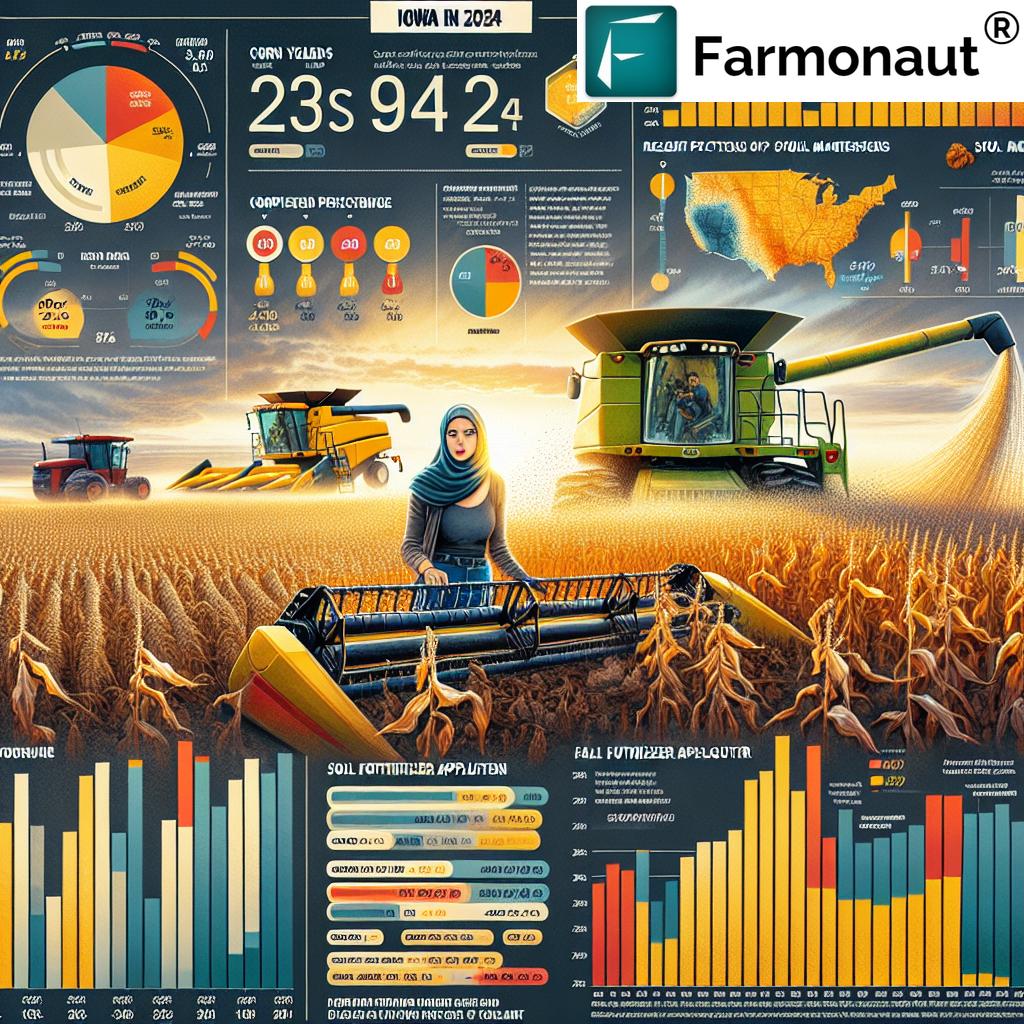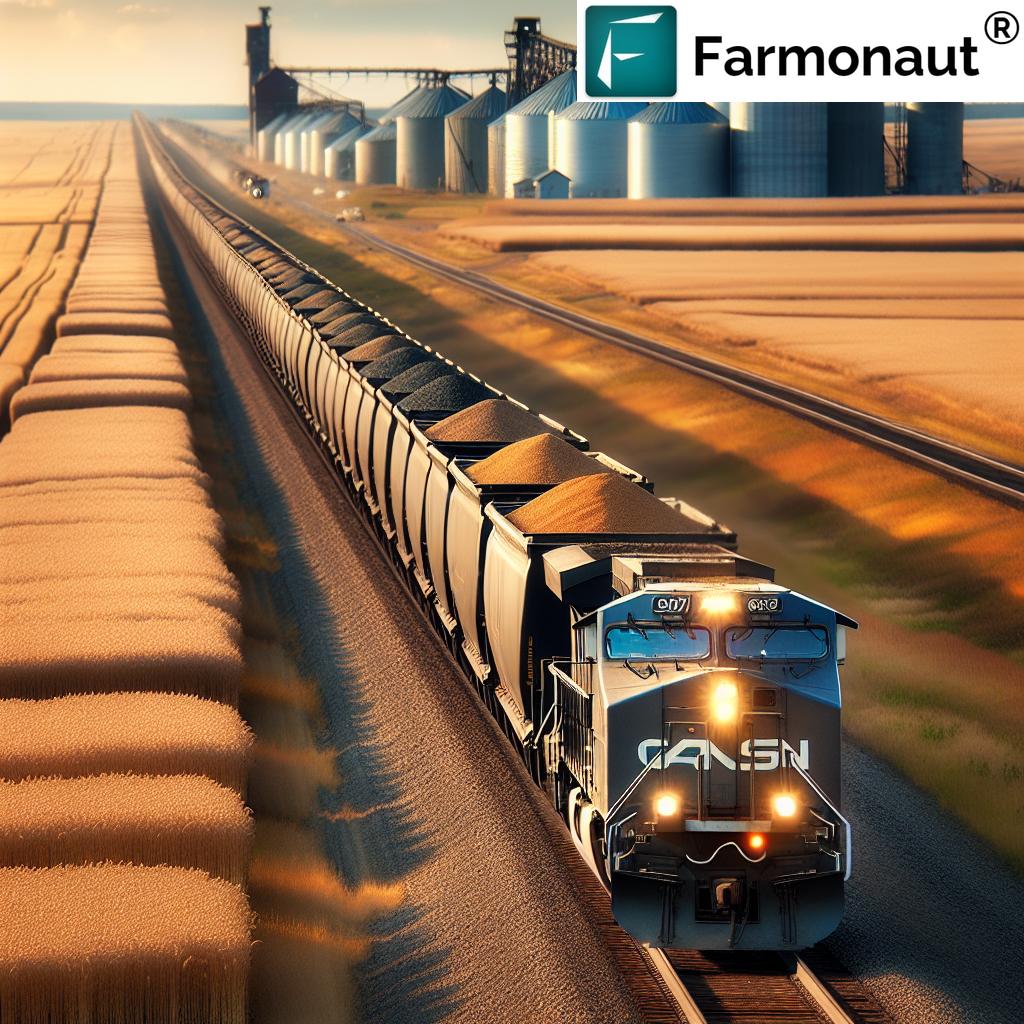Drought-Defying Harvest: Iowa’s Rapid Crop Progress Amid Challenging Weather Patterns

DES MOINES, Iowa (Oct. 28, 2024) – In a remarkable display of resilience, Iowa’s farmers are making swift progress in their crop harvest despite challenging weather conditions. The latest Iowa crop progress report reveals a story of determination and adaptability in the face of persistent drought and unusual weather patterns.
Iowa Crop Harvest Progress 2024: Beating the Odds
Iowa Secretary of Agriculture Mike Naig has provided insights into the current state of affairs, highlighting the impressive pace at which farmers are working. “Continued warm temperatures and dry conditions last week allowed for harvest to push forward at a brisk pace,” Naig stated. He added, “While corn harvest is likely to continue well into November, soybean harvest across Iowa is nearing completion.”
The USDA National Agricultural Statistics Service’s weekly report paints a picture of remarkable progress:
- Farmers enjoyed 6.7 days suitable for fieldwork during the week ending October 27, 2024.
- Corn harvest for grain reached 84% statewide, almost a week ahead of last year and 12 days ahead of the five-year average.
- The soybean harvest is nearly complete at an impressive 96%.
These statistics underscore the efficiency and determination of Iowa’s agricultural community in the face of adversity.
Drought Impact on Iowa Agriculture: A Closer Look
While the harvest progress is encouraging, the drought impact on agriculture in Iowa cannot be overlooked. The extended lack of rainfall has resulted in widespread drought conditions, posing significant challenges for farmers.

Key indicators of the drought’s impact include:
- Soil moisture levels are critically low, with 85% of topsoil moisture rated short to very short.
- Subsoil moisture conditions are equally concerning, with 80% rated short to very short.
- Pasture conditions in Iowa continue to deteriorate, with only 19% rated good to excellent.
These conditions pose significant challenges for farmers and underscore the need for advanced agricultural technologies. Farmers can leverage tools like the Farmonaut app to monitor crop health and optimize resource management in these trying times.
Iowa Corn and Soybean Yield Forecast: Defying Expectations
Despite the challenging conditions, Iowa’s farmers are demonstrating remarkable resilience. The corn yield is holding steady, with the moisture content of field corn being harvested at 14%. This is a testament to the advanced farming techniques and robust crop varieties being used across the state.
The soybean harvest is nearly complete, indicating that yields have largely met or exceeded expectations despite the drought conditions. This success can be attributed to factors such as:
- Improved drought-resistant crop varieties
- Efficient irrigation techniques
- Strategic planting schedules
- Utilization of precision agriculture technologies
Farmers looking to optimize their crop management strategies can benefit from satellite-based monitoring solutions. The Farmonaut Satellite API provides valuable insights for precision agriculture.
Fall Fertilizer Application in Iowa: Preparing for the Future
As harvest activities wind down, many Iowa farmers are turning their attention to fall fertilizer application. This crucial task sets the stage for the next growing season and helps maintain soil health. However, the current dry conditions present unique challenges for fertilizer application.
Farmers are advised to consider the following factors when planning their fertilizer strategies:
- Soil testing to determine precise nutrient needs
- Timing of application to maximize nutrient retention
- Selection of appropriate fertilizer types for current soil conditions
- Consideration of slow-release formulations to prevent nutrient loss
For detailed guidance on optimizing fertilizer application in challenging conditions, farmers can refer to the Farmonaut API Developer Docs, which provide valuable insights on integrating weather data with agricultural practices.
Iowa Weather Patterns Affecting Crops: A Mixed Blessing
The Iowa weather patterns have been a double-edged sword for farmers this season. While the warm, dry conditions have facilitated a rapid harvest, they have also exacerbated drought concerns. Key weather highlights include:
- Temperatures averaging 4.2 degrees above normal
- Rainfall totals below the 30-year climatological average
- Localized heavy rainfall in some eastern counties
- Freezing temperatures and frost in parts of the state
These variable conditions underscore the importance of real-time weather monitoring for agricultural decision-making. Farmers can access up-to-date weather data and forecasts through mobile applications like the Farmonaut Android app or the Farmonaut iOS app.
Iowa Soil Moisture Levels: A Growing Concern
The prolonged dry spell has taken a toll on Iowa soil moisture levels, raising concerns for the upcoming planting season. The latest agricultural statistics paint a worrying picture:
- 43% of topsoil moisture rated very short
- 42% rated short
- Only 15% rated adequate
- 0% surplus moisture reported
These conditions could have significant implications for the 2025 planting season if not addressed. Farmers are encouraged to implement water conservation measures and consider drought-resistant crop varieties for the coming year.
Iowa Pasture Conditions Report: Challenges for Livestock Farmers
The pasture conditions in Iowa continue to deteriorate, posing challenges for livestock farmers. The latest report indicates that only 19% of pastures are rated good to excellent. This decline is attributed to several factors:
- Shorter daylight hours
- Cooler temperatures
- Persistent dry conditions
Many pastures have gone dormant, forcing livestock farmers to rely more heavily on supplemental feed. This situation underscores the need for adaptive management strategies and highlights the interconnectedness of crop and livestock farming in Iowa’s agricultural landscape.
Looking Ahead: Preparing for an Uncertain Future
As Iowa’s farmers wrap up a challenging but productive harvest season, attention turns to the future. Secretary Naig noted, “Following what is likely to be one of the driest Octobers on record, weather outlooks for early November are indicating more chances for rainfall.”
This potential change in weather patterns could bring much-needed relief to the state’s parched soils. However, farmers must remain vigilant and prepared for ongoing challenges. Strategies for future success may include:
- Investing in water management infrastructure
- Adopting climate-smart agricultural practices
- Utilizing advanced weather forecasting and crop monitoring technologies
- Diversifying crop selections to spread risk
In conclusion, Iowa’s agricultural community has demonstrated remarkable resilience and adaptability in the face of challenging conditions. The rapid progress of the 2024 harvest, despite ongoing drought concerns, is a testament to the skill and determination of the state’s farmers. As they look to the future, continued innovation and adaptive management will be key to maintaining Iowa’s position as a leader in American agriculture.
For the latest updates on crop conditions, weather patterns, and agricultural technologies, farmers are encouraged to stay connected through resources like the Farmonaut platform and mobile applications. These tools provide valuable insights that can help navigate the complexities of modern farming in an ever-changing climate.
















